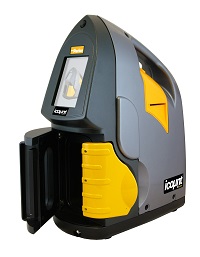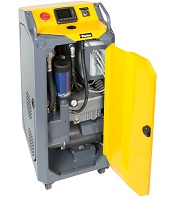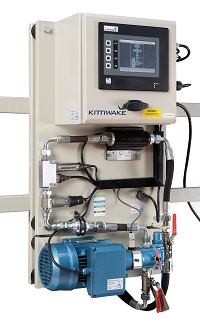Protecting Safety-Critical Offshore Assets
According to the recent Oil and Gas U.K. Health and Safety 2015 report, the industry is increasingly burdened with a growing backlog of safety-critical maintenance, putting vital equipment at a greatly increased risk of failure and placing even further strain on stretched budgets.
Whilst the mechanisms for identifying the early signs of wear and tear in safety-critical assets have become infinitely more advanced and capable, the tools are still almost as simple for engineers to use. The latest technologies enable maintenance engineers to make fast and informed “on the ground” decisions.
Water glycol testing for improved safety
Particularly key is safeguarding those systems associated with ensuring safety and preventing accidents, such as blowout preventers (BOPs), Crown Mounted Compensators (CMCs) and Riser Tensioner Systems (RTS). To prevent dangerous accidents, BOPs need to be closely monitored to ensure they remain operational to the required specifications.
The control fluids within the system must be tested for a number of parameters including cleanliness, particle contamination, the presence of corrosion by-products, bacterial growth and the concentration of glycol. If contaminated fluid is transferred through the umbilical to the BOP, it could cause the critical valves to stick. It is therefore essential in guaranteeing the safety of the equipment to ensure that the fluid is absolutely clean. This can now be monitored in real time by a sensor that sits topside, in the control fluid flow, monitoring the fluid and raising the alarm before any contaminated fluid can reach the BOP and cause damage.
 Engineers are already conducting these tests, however until now they have taken samples and shipped to onshore labs for analysis. This runs the risk of a significant delay in identifying a problem, during which time contaminated fluid could have been transferred to the BOP, causing damage and adding to the growing maintenance requirement.
Engineers are already conducting these tests, however until now they have taken samples and shipped to onshore labs for analysis. This runs the risk of a significant delay in identifying a problem, during which time contaminated fluid could have been transferred to the BOP, causing damage and adding to the growing maintenance requirement.
Parker’s new online Water Glycol icountPD unit can be used to safeguard RTS and CMCs as water glycol fluid cleanliness is critical to these applications too. The sensor monitors the fluid continuously and provides data online, immediately highlighting areas of concern as they occur. Used in conjunction with Parker’s icountBS Water Glycol test - a laboratory grade bottle sampler used to test fluid at any point in the system providing onboard results in real time, particularly where potential contamination has been identified by online monitoring - engineers are armed with the data they need to prevent damage. On-board testing allows swift results to be obtained, thus maintaining the integrity of the system and allowing any contamination to be spotted before damage occurs.
Oil purification to extend operational life
 Effective condition monitoring of modern hydraulic and lubrication systems has become crucial, not only to ensure compliance with increasingly stringent environmental regulations, but also for managing costs. Contaminated oil is often classified as chemical waste, which is far more expensive to dispose of than environmentally compliant waste products. Additionally, in order to protect the system from damage, operators are required to change the oil in the system, increasing costs and downtime.
Effective condition monitoring of modern hydraulic and lubrication systems has become crucial, not only to ensure compliance with increasingly stringent environmental regulations, but also for managing costs. Contaminated oil is often classified as chemical waste, which is far more expensive to dispose of than environmentally compliant waste products. Additionally, in order to protect the system from damage, operators are required to change the oil in the system, increasing costs and downtime.
Water contamination in oil can have a significant impact on the component parts of the system, with the operational life of bearings reduced by nearly half with 200 ppm of water present in the oil. Water also accelerates the ageing of oil by more than 50%, halving its operational life.
Purification systems such as the Parker Sentinel Compact Portable Oil Purifier extend the usable life of fluids by monitoring the level of contamination to inform corrective action. Using both vacuum dehydration and filtration technology to purify the oil and remove contamination from water, solids, or gases, the Sentinel purifier ensures that only clean, dry oil is pumped back into the system. By extending the life of the oil, operators can reduce costs, prevent damage and maximize operational efficiency.
Lube oil analysis to increase uptime
As the lifeblood of many valuable assets, it is vital that the condition of lubricating oil is closely monitored and that engineers have the accurate information they need quickly. With lower oil prices, budgets across the board are tight, and safely maximizing the life of lubricating oil is paramount to protecting the operational lifespan of the asset, ultimately achieving significant maintenance efficiencies and cost savings.
Essential assets such as thrusters are critical to the running of offshore vessels such as drilling rigs and Floating Production Storage & Offloading vessels (FPSOs). The deepwater operations of these vessels require dynamic positioning systems, themselves dependent on thruster availability. The safe operation of thrusters is key to the operational output of the vessel, and the consequences of thruster failure – both in terms of lost revenue from operational downtime and replacement and repair costs – are severe.
Even if a replacement thruster is available locally and at short notice, replacement as a result of an unplanned or sudden failure will be expensive; $10 million can disappear in a heartbeat. Very few are replaceable underwater without dry-docking, however this still requires that the vessel moves away from the area of operation and into a safe zone where the thruster can be replaced. For the majority that have to be dry-docked, there are multiple challenges; steaming an FPSO is a serious and costly undertaking, drydock capacity for FPSOs is very limited, and certain thrusters are used for both dynamic positioning and primary propulsion of vessels so, with a thruster short, there is added difficulty in moving it.
 Online monitoring systems, such as Parker’s ThrusterSCAN system provide an early warning of thruster component damage, lubricant degradation, and seal leaks and failures; providing essential information to help optimize thruster operating parameters and effectively manage overhaul schedules. As a real-time condition monitoring tool, ThrusterSCAN continuously monitors for metallic wear debris (from bearing/gear damage), water ingress and oil degradation. Early identification of damage enables the planning of maintenance to bring the least impact to operational efficiency and minimize contractual losses from unplanned maintenance.
Online monitoring systems, such as Parker’s ThrusterSCAN system provide an early warning of thruster component damage, lubricant degradation, and seal leaks and failures; providing essential information to help optimize thruster operating parameters and effectively manage overhaul schedules. As a real-time condition monitoring tool, ThrusterSCAN continuously monitors for metallic wear debris (from bearing/gear damage), water ingress and oil degradation. Early identification of damage enables the planning of maintenance to bring the least impact to operational efficiency and minimize contractual losses from unplanned maintenance.
A proactive approach to safety and reliability not only helps to win contracts, but it can also maximize profits from existing contracts. Moreover, when budgets are stretched, it becomes particularly key to safeguarding those systems vital to the running of the platform or vessel, which cannot be compromised. Condition monitoring has seen a period of rapid development, from engineers physically examining oil for signs of degradation, listening for tell-tale rattling sounds and feeling machinery parts for vibrations and heat, to a full suite of sophisticated and accurate condition monitoring tools.
By employing comprehensive condition monitoring across the entire operation, engineers can avoid adding to the backlog for maintenance requirements and ensure that the platform continues to run safely and efficiently.
The products and services herein described in this press release are not endorsed by The Maritime Executive.
